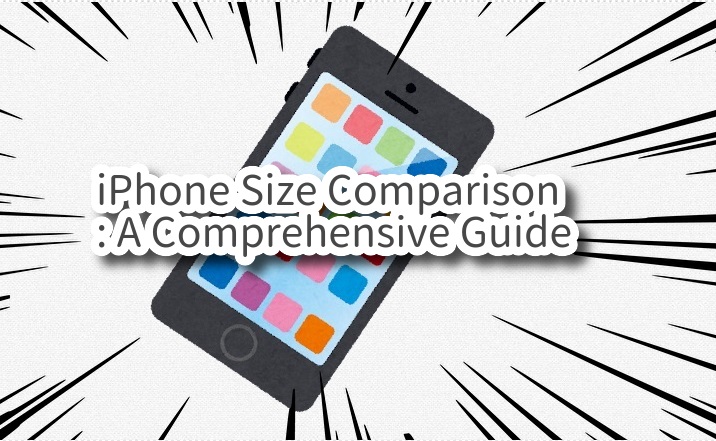When it comes to smartphones, Apple’s iPhone has consistently been at the forefront of innovation and design. One of the most significant aspects that consumers consider when purchasing a new device is its size. With various models released over the years, understanding the differences in size can help users make informed decisions. In this article, we will explore the size comparisons of different iPhone models, discuss how size impacts usability, and provide insights into choosing the right iPhone for your needs.
1. The Evolution of iPhone Sizes
Since the launch of the original iPhone in 2007, Apple has introduced numerous models, each varying in size and design. The evolution of iPhone sizes can be categorized into several generations:
1.1. The Early Years (iPhone 1 to iPhone 4s)
The original iPhone featured a 3.5-inch display, which was considered large at the time. This size remained consistent until the iPhone 4, which introduced a Retina display while maintaining the same dimensions. The iPhone 4s continued this trend, offering a compact and sleek design that appealed to many users.
1.2. The Transition to Larger Displays (iPhone 5 to iPhone 8)
With the release of the iPhone 5 in 2012, Apple made a significant shift by increasing the screen size to 4 inches. This change marked the beginning of a trend towards larger displays. The iPhone 6 and 6 Plus, released in 2014, further expanded the size range, introducing 4.7-inch and 5.5-inch displays, respectively. This was a pivotal moment as consumers began to favor larger screens for media consumption and productivity.
1.3. The Modern Era (iPhone X to iPhone 14)
The iPhone X, launched in 2017, introduced a new design language with a 5.8-inch display, while the iPhone 11 Pro Max followed with a 6.5-inch screen. The iPhone 12 series continued this trend, with the iPhone 12 mini offering a compact 5.4-inch display, catering to users who preferred smaller devices. The iPhone 13 and 14 series maintained similar sizes, with the Pro models offering larger displays for enhanced user experience.
2. Size Comparison of Current iPhone Models
To provide a clearer understanding of the size differences among the latest iPhone models, let’s compare their dimensions and display sizes.
| Model | Height (mm) | Width (mm) | Depth (mm) | Display Size (inches) |
|---|---|---|---|---|
| iPhone 14 | 146.7 | 71.5 | 7.8 | 6.1 |
| iPhone 14 Pro | 147.5 | 71.5 | 7.85 | 6.1 |
| iPhone 14 Pro Max | 160.7 | 77.6 | 7.85 | 6.7 |
| iPhone 14 mini | 131.5 | 64.2 | 7.8 | 5.4 |
| iPhone SE (3rd Gen) | 138.4 | 67.3 | 7.3 | 4.7 |
2.1. Compact vs. Large Models
The iPhone SE (3rd Gen) is the smallest model currently available, featuring a 4.7-inch display. It is ideal for users who prefer a more compact device that can easily fit in a pocket. On the other hand, the iPhone 14 Pro Max, with its 6.7-inch display, is designed for those who enjoy consuming media, gaming, and multitasking on a larger screen.
2.2. Weight Considerations
In addition to dimensions, weight is another crucial factor to consider. Heavier devices may feel more premium but can also be cumbersome for prolonged use. Here’s a quick look at the weights of the current models:
| Model | Weight (grams) |
|---|---|
| iPhone 14 | 172 |
| iPhone 14 Pro | 206 |
| iPhone 14 Pro Max | 240 |
| iPhone 14 mini | 140 |
| iPhone SE (3rd Gen) | 144 |
3. Impact of Size on Usability
3.1. One-Handed Use
One of the most significant considerations when choosing an iPhone size is how comfortable it is to use with one hand. Smaller models like the iPhone SE and iPhone 14 mini are easier to handle, allowing users to reach all corners of the screen without adjusting their grip. In contrast, larger models may require two hands for certain tasks, which can be inconvenient in situations where multitasking is necessary.
3.2. Media Consumption
For users who enjoy watching videos, playing games, or browsing the web, larger displays provide a more immersive experience. The iPhone 14 Pro Max, with its expansive screen, is particularly well-suited for these activities. The increased screen real estate allows for better visibility and a more enjoyable viewing experience.
3.3. Portability
While larger screens offer advantages in usability, they can also impact portability. Users who frequently travel or prefer to carry their devices in smaller bags may find larger models cumbersome. The iPhone 14 mini and iPhone SE are excellent choices for those prioritizing portability without sacrificing performance.
4. Choosing the Right iPhone Size for You
When deciding on the right iPhone size, consider the following factors:
4.1. Personal Preference
Ultimately, personal preference plays a significant role in choosing the right size. Some users may prefer the compactness of smaller models, while others may enjoy the larger displays for their functionality.
4.2. Usage Habits
Consider how you plan to use your iPhone. If you primarily use it for texting and calling, a smaller model may suffice. However, if you frequently watch videos or play games, a larger model may enhance your experience.
4.3. Budget
Price can also influence your decision. Larger models often come with a higher price tag, so it’s essential to weigh your budget against your size preference and usage needs.
5. Conclusion
In conclusion, the size of an iPhone can significantly impact usability, comfort, and overall user experience. With a variety of models available, from the compact iPhone SE to the expansive iPhone 14 Pro Max, there is an option for every type of user. By considering your personal preferences, usage habits, and budget, you can make an informed decision that best suits your needs. Whether you prioritize portability or a larger display for media consumption, understanding the size differences among iPhone models will help you choose the perfect device for your lifestyle.


